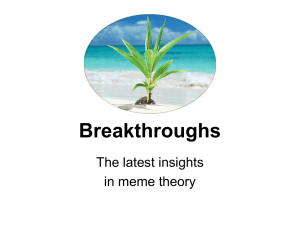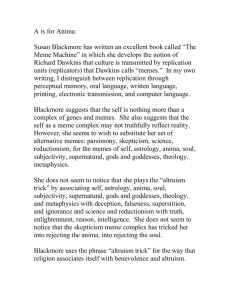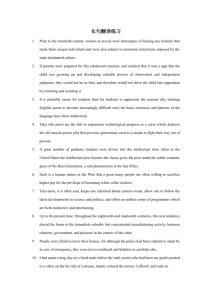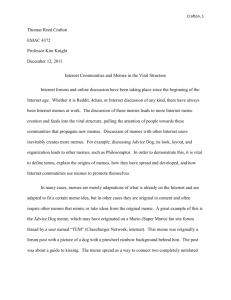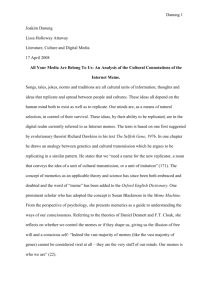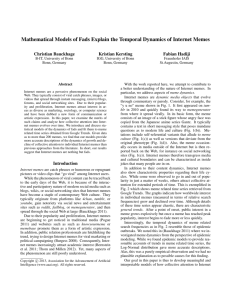The meme machine
advertisement
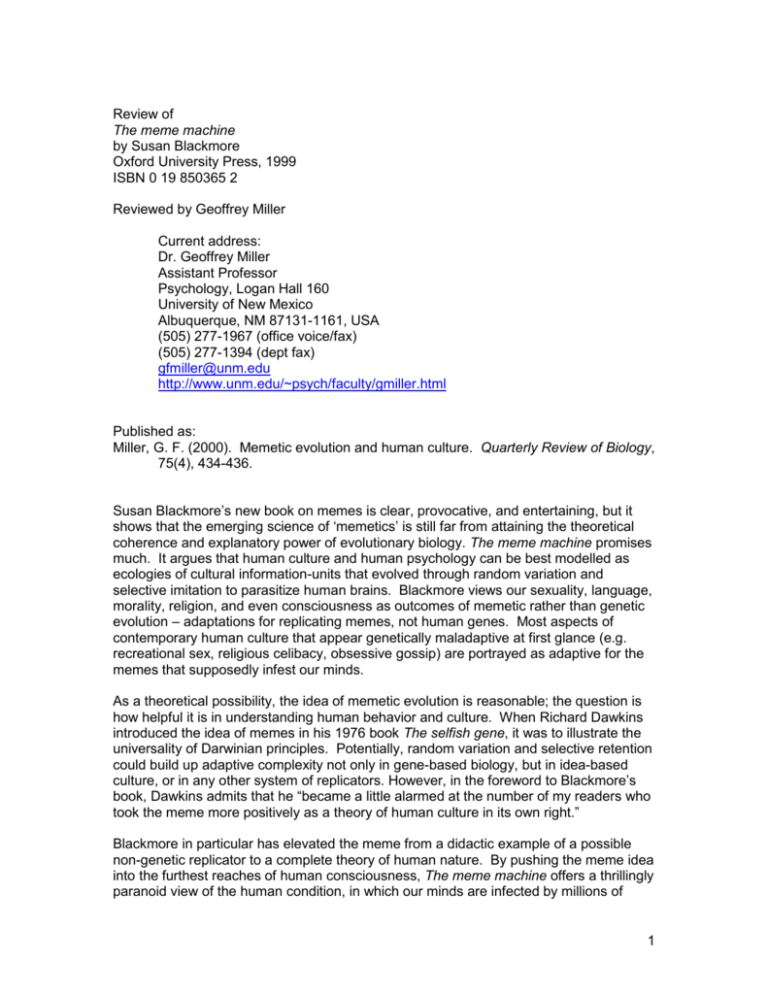
Review of The meme machine by Susan Blackmore Oxford University Press, 1999 ISBN 0 19 850365 2 Reviewed by Geoffrey Miller Current address: Dr. Geoffrey Miller Assistant Professor Psychology, Logan Hall 160 University of New Mexico Albuquerque, NM 87131-1161, USA (505) 277-1967 (office voice/fax) (505) 277-1394 (dept fax) gfmiller@unm.edu http://www.unm.edu/~psych/faculty/gmiller.html Published as: Miller, G. F. (2000). Memetic evolution and human culture. Quarterly Review of Biology, 75(4), 434-436. Susan Blackmore’s new book on memes is clear, provocative, and entertaining, but it shows that the emerging science of ‘memetics’ is still far from attaining the theoretical coherence and explanatory power of evolutionary biology. The meme machine promises much. It argues that human culture and human psychology can be best modelled as ecologies of cultural information-units that evolved through random variation and selective imitation to parasitize human brains. Blackmore views our sexuality, language, morality, religion, and even consciousness as outcomes of memetic rather than genetic evolution – adaptations for replicating memes, not human genes. Most aspects of contemporary human culture that appear genetically maladaptive at first glance (e.g. recreational sex, religious celibacy, obsessive gossip) are portrayed as adaptive for the memes that supposedly infest our minds. As a theoretical possibility, the idea of memetic evolution is reasonable; the question is how helpful it is in understanding human behavior and culture. When Richard Dawkins introduced the idea of memes in his 1976 book The selfish gene, it was to illustrate the universality of Darwinian principles. Potentially, random variation and selective retention could build up adaptive complexity not only in gene-based biology, but in idea-based culture, or in any other system of replicators. However, in the foreword to Blackmore’s book, Dawkins admits that he “became a little alarmed at the number of my readers who took the meme more positively as a theory of human culture in its own right.” Blackmore in particular has elevated the meme from a didactic example of a possible non-genetic replicator to a complete theory of human nature. By pushing the meme idea into the furthest reaches of human consciousness, The meme machine offers a thrillingly paranoid view of the human condition, in which our minds are infected by millions of 1 cultural viruses. By the end, the reader can almost feel those nefarious memes pushing one’s buttons, running one’s life, and constructing the grand illusion of personal identity. Blackmore adopts Salvador Dali’s “paranoic-critical attitude” to good rhetorical effect, offering a surreal alternative to the current evolutionary psychology view that our behavior is generally in our genetic interests. Yet her perspective does not lead to a coherent theory of memetic adaptations, because it is too centered on the human psychological effects of memetic evolution rather than the dynamics of memetic evolution itself. This anthropocentric, psychological focus leads to several problems. Most importantly, Blackmore posits a number of feedback loops between memetic evolution and the genetic evolution of human psychological adaptations for language, morality, and consciousness, but it is never quite clear how these work from the selfish meme’s point of view. How precisely can memes force genes “to build ever better and better memespreading devices” (p. 119)? The clearest mechanism that Blackmore offers depends on sexual selection in favor of the best meme-producers: “mate with the man with the most memes” (p. 79). This is a fascinating but only partially developed idea. Blackmore claims that memes have largely slipped the leash of our genetic self-interest, since they often confer no survival utility on us. However, if “people preferentially mated with the best meme-spreaders, in this case the most articulate people” (p. 105), we would expect meme-spreading to bring mainly reproductive benefits, through increasing our sexual attractiveness, rather than survival benefits. To make a strong case for memes evolving contrary to our genetic interests, Blackmore would have to show that most of our memes lower our sexual attractiveness. This seems unlikely to be the case, given that the classic examples of memes – songs, fashions, moral ideals, religious convictions – are adopted and advertised by young adults precisely for their sexual appeal. Also, the fact that young males invent and propagate many more memes than other demographic groups suggests that memespreading remains genetically adaptive: males try to attract multiple sexual partners through various artistic, musical, and ideological displays, while most females still invest much less in this sort of courtship effort. If memes were truly in the driver’s seat, females would burn huge amounts of energy propagating many more memes than necessary to attract a high-quality partner. The meme machine argues against the current evolutionary psychology view that much of human culture promotes the genetic interests of particular individuals. However, its arguments fail to recognize that those genetic interests are principally reproductive, and that most apparently memetic phenomena may be outcomes of runaway sexual selection rather than runaway cultural evolution. In particular, I wonder how many “memeplexes” (complex, co-adapted sets of memes, such as symphonies, inventions, and religions) actually evolved through a gradual, cumulative cultural selection process, versus being invented all at once by particular individuals trying to improve their sociosexual status. In my view, most memeplexes are products of individual human genius rather than abstract cultural evolution. The memetic evolution that did occur was within one individual’s brain, through a process of artificial selection in which the capricious products of human creativity were repeatedly tested against that individual’s own aesthetic and intellectual judgment, and their mental model of other people’s tastes. Beethoven’s musical memes have succeeded because Beethoven put great creative effort into crafting music to please his audience, not because his audience selectively imitated and mutated his best ideas. 2 Another pervasive problem is that Blackmore often commits a sort of memetic groupselection fallacy, in which individual memes are viewed as altruistically striving for the greater good of memes in general, at the expense of human genetic interests. She agrees with Dan Dennett that memes can “restructure a human brain in order to make it a better habitat for memes” (p. 22). This would be analogous to individual species of weeds altruistically improving soil quality for the good of the plant kingdom in general. Also, she appears to argue that the meme for using birth control evolved to reduce the parental investment that people make in offspring, leaving more time and energy available for spreading other memes. Again, it is unclear why the birth control meme should altruistically modify people’s behavior so they can better propagate other, competing memes. By contrast, Blackmore’s memetic models of human altruism and self-consciousness do not fall prey to such group-selection errors, as far as I can tell. The meme machine would make a good discussion book for a graduate seminar in evolutionary theory, insofar as students could play “spot the group-selection fallacies” at this level of cultural evolution, where such fallacies are less obvious than in biology. The third major problem is that meme theories tend to ignore the powerful institutions that dominate modern human culture. This often leads meme theorists to mis-describe marketing and advertising phenomena as cultural evolution effects. For example, Blackmore repeats theologian Hugh Pyper’s suggestion that “Western culture is the Bible’s way of making more Bibles” (p. 192). This view portrays the world as composed of minds and memes, while ignoring the existence of the Catholic church. Such religious institutions are much more than memes – historically, they have had enormous political, economic, and military power, supported by the most advanced marketing and advertising technologies of the day (musical rituals, stained glass images, indoctrination centers called monasteries, group tourism experiences called pilgrimages, etc.) The same argument applies even more clearly to fashions in clothing and popular music. These are not just memes that arise randomly and get propagated in proportion to their intrinsic psychological appeal. Rather, they are invented and advertised by huge corporate teams of professional marketers, supported by vast promotional budgets and sophisticated networks of publicists and journalists. Consider the ubiquity of “Star Wars: Episode 1” toys. A meme theorist might suggest that the meme for “pod racers” must have arisen by chance, and replicated itself through imitation, because it pushed the right psychological buttons. On the other hand, a marketing executive might observe that the Star Wars merchandizing campaign was supported by a promotional budget in excess of 100 million dollars. The toys were everywhere because the toy manufacturers were efficient at distributing them to many retail outlets, in the financial (and presumably genetic) interests of their share-holders. In the commercial world, corporations are much more powerful than the memes they propagate – they use patent and copyright law very effectively to prohibit the unauthorized imitation of their ideas and designs. If the Windows software was really a meme in charge of its own replication, Microsoft would never sue imitators for software piracy. Meme theory has never taken root in business schools, perhaps because the memetic view of culture is descriptively and predictively useless to the marketing executives who actually determine the contents of modern human culture. Blackmore is worried about memes that are “positively harmful – like chain letters and pyramid selling, new methods of fraud and false doctrines, ineffective slimming diets and dangerous medical ‘cures’” 3 (p. 7). However, most such memes are products of deliberate design by self-interested humans, not cumulative evolution at the cultural level. By overlooking the individual and institutional interests served by cultural phenomena, meme theory risks leading people into a naïve passivity in the face of manipulative marketing by corporations, churches, and states. I agree with Blackmore that we should always ask, of any cultural phenomenon, cui bono? (Who benefits?). However, genes and memes are not the only alternatives as beneficiaries – there are institutions that can be treated as self-interested agents for purposes of economic, political, sociological, and cultural analysis. To clarify whether the meme theory is really useful in understanding human culture, we need much more detailed case studies of memetic evolution from traditional, data-rich disciplines: studies of words in historical linguistics, studies of melodic themes in musicology, studies of theories in the history of science, studies of patents in engineering, studies of precedents in law. Only when we find cultural phenomena that are contrary to both the reproductive interests of individuals and the power interests of institutions should we consider the meme theory the most appropriate explanation. Despite its faults, The meme machine is an entertaining, scholarly, adventurous book that would interest most evolutionary biologists. It presents a radical new vision of the human condition in which we are unconscious hosts to ideas that evolved to serve their own reproductive needs, not ours. Blackmore articulates that vision with intellectual bravado and imagination. Yet her arguments are unlikely to convince evolutionary psychologists who discern reproductive benefits in most human cultural behavior, or social scientists who worry that modern culture is dominated by the institutional power of marketers, advertisers, and publicists. 4
